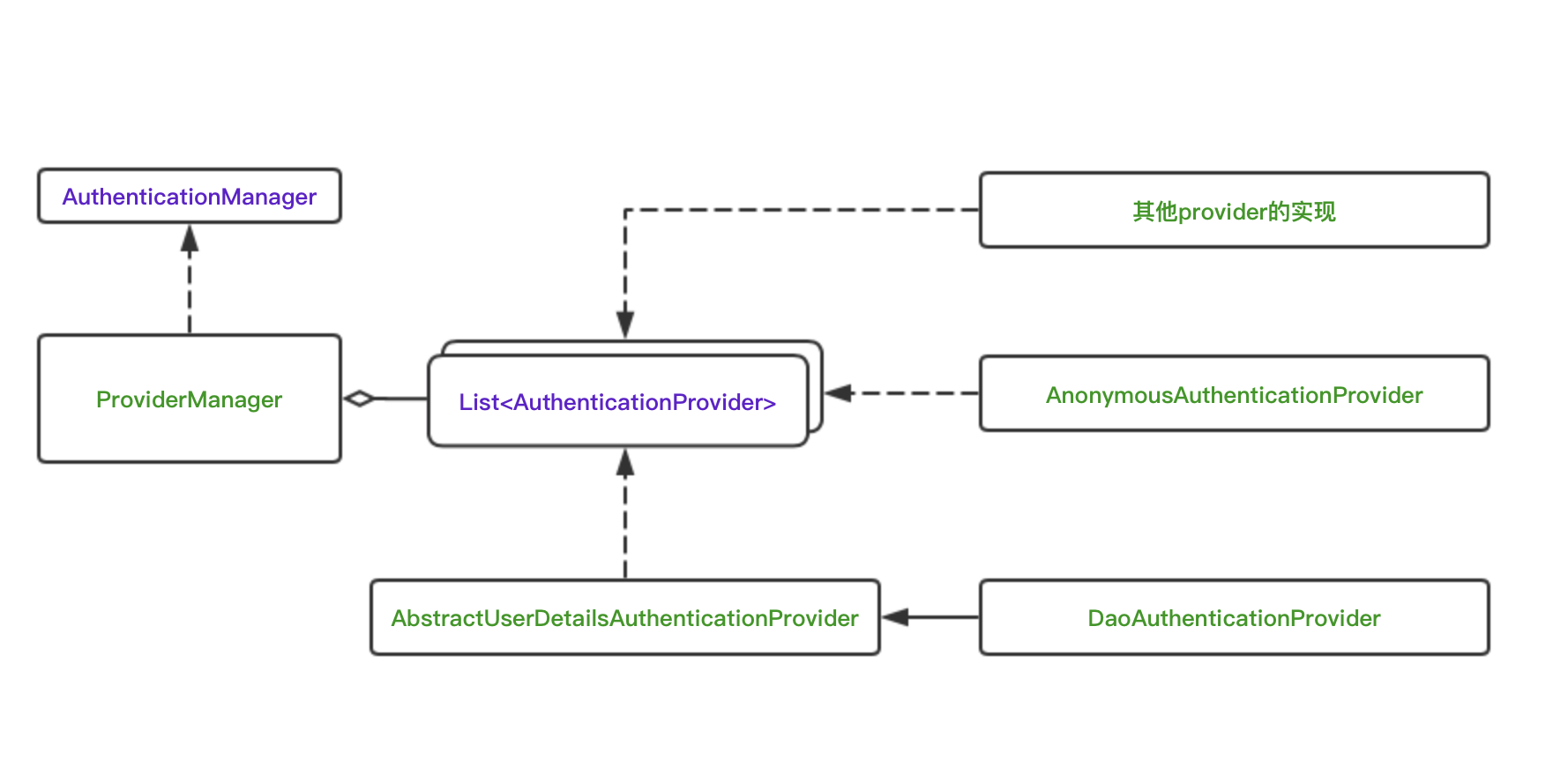作者:Dayeh@小米安全中心 首席音乐家
Spring Security 5.1.4 RELEASE
书接上文,在上一篇中介绍了Spring Security的基本组件以及基本的认证流程,此篇介绍一下Spring Security的一些核心服务。
2 核心服务
Spring Security中还有许多十分重要的接口,特别是AuthenticationManager, UserDetailsService 和AccessDecisionManager,Spring Security提供了一些实现,用户亦可自己实现定制的认证授权机制。下面我们来具体看一下几个接口及Spring Security提供的实现,从而有助于了解在认证授权环节中它们的具体作用,以及如何使用。
2.1 AuthenticationManager, ProviderManager and AuthenticationProvider
AuthenticationManger是一个接口,用来完成认证的逻辑,开发者可按照自己的项目设计需求进行实现。如果,我们希望能够组合使用多种认证服务,比如基于数据库和LDAP服务器的认证服务,Spring Security也是支持的。
ProviderManager是Spring Security提供的一个实现,但是它本身不处理认证请求,而是将任务委托给一个配置好的AuthenticationProvider的列表,其中每一个AuthenticationProvider按序确认能否完成认证,每个provider如果认证失败,会抛出一个异常,如果认证通过,则会返回一个Authentication对象。
AuthenticationManager
AuthenticationManger是一个接口,其中只有一个方法authenticate,用来尝试对传入的Authentication对象进行认证。
这里保留了源码中的一大段注释,其中包括了该接口的作用,以及在实现时应当注意的一些问题,这里不多做叙述,我们目前只需要了解这个接口的作用即可,感兴趣的同学可以自行阅读源码中的注释。
/**
* Processes an {@link Authentication} request.
*
* @author Ben Alex
*/
public interface AuthenticationManager {
// ~ Methods
// ========================================================================================================
/**
* Attempts to authenticate the passed {@link Authentication} object, returning a
* fully populated <code>Authentication</code> object (including granted authorities)
* if successful.
* <p>
* An <code>AuthenticationManager</code> must honour the following contract concerning
* exceptions:
* <ul>
* <li>A {@link DisabledException} must be thrown if an account is disabled and the
* <code>AuthenticationManager</code> can test for this state.</li>
* <li>A {@link LockedException} must be thrown if an account is locked and the
* <code>AuthenticationManager</code> can test for account locking.</li>
* <li>A {@link BadCredentialsException} must be thrown if incorrect credentials are
* presented. Whilst the above exceptions are optional, an
* <code>AuthenticationManager</code> must <B>always</B> test credentials.</li>
* </ul>
* Exceptions should be tested for and if applicable thrown in the order expressed
* above (i.e. if an account is disabled or locked, the authentication request is
* immediately rejected and the credentials testing process is not performed). This
* prevents credentials being tested against disabled or locked accounts.
*
* @param authentication the authentication request object
*
* @return a fully authenticated object including credentials
*
* @throws AuthenticationException if authentication fails
*/
Authentication authenticate(Authentication authentication)
throws AuthenticationException;
}
ProviderManager
ProviderManager是Authentication的一个实现,并将具体的认证操作委托给一系列的AuthenticationProvider来完成,从而可以实现支持多种认证方式。为了帮助阅读和理解源码具体做了什么,这里删除了原来的一部分注释,并对重要的部分进行了注释说明。
public class ProviderManager implements AuthenticationManager, MessageSourceAware,
InitializingBean {
private static final Log logger = LogFactory.getLog(ProviderManager.class);
private AuthenticationEventPublisher eventPublisher = new NullEventPublisher();
private List<AuthenticationProvider> providers = Collections.emptyList();
protected MessageSourceAccessor messages = SpringSecurityMessageSource.getAccessor();
private AuthenticationManager parent;
private boolean eraseCredentialsAfterAuthentication = true;
/**
* 用List<AuthenticationProvider>初始化一个ProviderManager
* 也就是上文提到的,ProviderManager将具体的认证委托给不同的provider,从而支持不同的认证方式
*/
public ProviderManager(List<AuthenticationProvider> providers) {
this(providers, null);
}
/**
* 也可以为其设置一个父类
*/
public ProviderManager(List<AuthenticationProvider> providers,
AuthenticationManager parent) {
Assert.notNull(providers, "providers list cannot be null");
this.providers = providers;
this.parent = parent;
checkState();
}
public void afterPropertiesSet() throws Exception {
checkState();
}
private void checkState() {
if (parent == null && providers.isEmpty()) {
throw new IllegalArgumentException(
"A parent AuthenticationManager or a list "
+ "of AuthenticationProviders is required");
}
}
/**
* ProviderManager的核心方法,authentication方法尝试对传入的Authentication对象进行认证,传入的Authentication是
* 以用户的提交的认证信息,比如用户名和密码,创建的一个Authentication对象。
*
* 会依次询问各个AuthenticationProvider,当provider支持对传入的Authentication认证,
* 便会尝试使用该provider进行认证。如果有多个provider都支持认证传入的Authentication对象,
* 则只会使用第一个支持的provider进行认证。
*
* 一旦有一个provider认证成功了,便会忽略之前任何provider抛出的异常,之后的provider也不会再
* 继续认证的尝试。
*
* 如果所有provider都认证失败,方法则会抛出最后一个provider抛出的异常。
*/
public Authentication authenticate(Authentication authentication)
throws AuthenticationException {
Class<? extends Authentication> toTest = authentication.getClass();
AuthenticationException lastException = null;
AuthenticationException parentException = null;
Authentication result = null;
Authentication parentResult = null;
boolean debug = logger.isDebugEnabled();
// 依次使用各个provider尝试进行认证
for (AuthenticationProvider provider : getProviders()) {
// 如果provider不支持对传入的Authentication进行认证,则跳过。
if (!provider.supports(toTest)) {
continue;
}
if (debug) {
logger.debug("Authentication attempt using "
+ provider.getClass().getName());
}
try {
// 调用provider的authenticate方法进行认证
result = provider.authenticate(authentication);
// 如果认证成功,则将authentication中用户的细节信息复制到result中
// 然后跳出循环,不再尝试后面其他的provider
if (result != null) {
copyDetails(authentication, result);
break;
}
}
catch (AccountStatusException e) {
prepareException(e, authentication);
// 如果待认证的账号信息无误,但是账号本身异常,比如账号停用了,则抛出AccountStatusException异常,
// 并通过prepareException方法,发布一个AbstractAuthenticationFailureEvent,避免继续尝试其他provider进行认证
throw e;
}
catch (InternalAuthenticationServiceException e) {
prepareException(e, authentication);
throw e;
}
catch (AuthenticationException e) {
// 如果该provider认证失败,捕获异常AuthenticationException后不抛出,继续尝试下一个provider
// lastException会记录下最后一个认证失败的provider抛出的AuthenticationException异常。
lastException = e;
}
}
if (result == null && parent != null) {
// 如果所有provider都没能认证成功,则交给父类尝试认证
try {
result = parentResult = parent.authenticate(authentication);
}
catch (ProviderNotFoundException e) {
// 父类如果抛出该异常不做处理,因为后面有对子类抛出该异常的处理
}
catch (AuthenticationException e) {
// 父类也没能认证成功,则最后一个异常为来自父类认证失败的异常
lastException = parentException = e;
}
}
if (result != null) {
if (eraseCredentialsAfterAuthentication
&& (result instanceof CredentialsContainer)) {
// 认证成功,从Authentication中删除密码秘钥等敏感信息
((CredentialsContainer) result).eraseCredentials();
}
// 如果父类认证成功,则会发布一个AuthenticationSuccessEvent,
// 这一步检查,防止子类重复发布
if (parentResult == null) {
eventPublisher.publishAuthenticationSuccess(result);
}
//返回的result为一个Authentication,其中包含了已认证用户的信息
return result;
}
if (lastException == null) {
lastException = new ProviderNotFoundException(messages.getMessage(
"ProviderManager.providerNotFound",
new Object[] { toTest.getName() },
"No AuthenticationProvider found for {0}"));
}
// 如果父类认证失败,会发布一个AbstractAuthenticationFailureEvent
// 这一步检查,防止子类重复发布
if (parentException == null) {
prepareException(lastException, authentication);
}
throw lastException;
}
@SuppressWarnings("deprecation")
private void prepareException(AuthenticationException ex, Authentication auth) {
eventPublisher.publishAuthenticationFailure(ex, auth);
}
/**
* 从source中复制用户的信息到dest
*
* Copies the authentication details from a source Authentication object to a
* destination one, provided the latter does not already have one set.
*
* @param source source authentication
* @param dest the destination authentication object
*/
private void copyDetails(Authentication source, Authentication dest) {
if ((dest instanceof AbstractAuthenticationToken) && (dest.getDetails() == null)) {
AbstractAuthenticationToken token = (AbstractAuthenticationToken) dest;
token.setDetails(source.getDetails());
}
}
public List<AuthenticationProvider> getProviders() {
return providers;
}
public void setMessageSource(MessageSource messageSource) {
this.messages = new MessageSourceAccessor(messageSource);
}
public void setAuthenticationEventPublisher(
AuthenticationEventPublisher eventPublisher) {
Assert.notNull(eventPublisher, "AuthenticationEventPublisher cannot be null");
this.eventPublisher = eventPublisher;
}
/**
* 设置是否要在认证完成后,让Authentication调用自己的eraseCredentials方法来清除密码信息。
*
* If set to, a resulting {@code Authentication} which implements the
* {@code CredentialsContainer} interface will have its
* {@link CredentialsContainer#eraseCredentials() eraseCredentials} method called
* before it is returned from the {@code authenticate()} method.
*
* @param eraseSecretData set to {@literal false} to retain the credentials data in
* memory. Defaults to {@literal true}.
*/
public void setEraseCredentialsAfterAuthentication(boolean eraseSecretData) {
this.eraseCredentialsAfterAuthentication = eraseSecretData;
}
public boolean isEraseCredentialsAfterAuthentication() {
return eraseCredentialsAfterAuthentication;
}
private static final class NullEventPublisher implements AuthenticationEventPublisher {
public void publishAuthenticationFailure(AuthenticationException exception,
Authentication authentication) {
}
public void publishAuthenticationSuccess(Authentication authentication) {
}
}
}
至此可以看到,ProviderManager的认证逻辑还是很简单清晰的,我们也可以比较清楚理解AuthenticationManager,ProviderManager和AuthenticationProvider的关系了。
AuthenticationProvider
AuthenticationProvider也是一个接口,用来完成具体的认证逻辑。不同的认证方式有不同的实现,Spring Security中提供了多种实现,包括DaoAuthenticationProvider,AnonymousAuthenticationProvider和LdapAuthenticationProvider等。其中最简单的DaoAuthenticationProvider会在后面介绍,首先来看一下AuthenticationProvider的源码。同样的,保留了源码中的注释,感兴趣的同学可以细读,这里只做简单的介绍。
可以看到,AuthenticationProvider中只有2个方法:
- authenticate完成具体的认证逻辑,如果认证失败,抛出AuthenticationException异常
- supports判断是否支持传入的Authentication认证信息
/**
* Indicates a class can process a specific
* {@link org.springframework.security.core.Authentication} implementation.
*
* @author Ben Alex
*/
public interface AuthenticationProvider {
// ~ Methods
// ========================================================================================================
/**
* Performs authentication with the same contract as
* {@link org.springframework.security.authentication.AuthenticationManager#authenticate(Authentication)}
* .
*
* @param authentication the authentication request object.
*
* @return a fully authenticated object including credentials. May return
* <code>null</code> if the <code>AuthenticationProvider</code> is unable to support
* authentication of the passed <code>Authentication</code> object. In such a case,
* the next <code>AuthenticationProvider</code> that supports the presented
* <code>Authentication</code> class will be tried.
*
* @throws AuthenticationException if authentication fails.
*/
Authentication authenticate(Authentication authentication)
throws AuthenticationException;
/**
* Returns <code>true</code> if this <Code>AuthenticationProvider</code> supports the
* indicated <Code>Authentication</code> object.
* <p>
* Returning <code>true</code> does not guarantee an
* <code>AuthenticationProvider</code> will be able to authenticate the presented
* instance of the <code>Authentication</code> class. It simply indicates it can
* support closer evaluation of it. An <code>AuthenticationProvider</code> can still
* return <code>null</code> from the {@link #authenticate(Authentication)} method to
* indicate another <code>AuthenticationProvider</code> should be tried.
* </p>
* <p>
* Selection of an <code>AuthenticationProvider</code> capable of performing
* authentication is conducted at runtime the <code>ProviderManager</code>.
* </p>
*
* @param authentication
*
* @return <code>true</code> if the implementation can more closely evaluate the
* <code>Authentication</code> class presented
*/
boolean supports(Class<?> authentication);
}DaoAuthenticationProvider
DaoAuthenticationProvider是Spring Security提供的最简单的一个AuthenticationProvider的实现,也是框架中最早支持的。它使用UserDetailsService作为一个DAO来查询用户名、密码以及用户的权限GrantedAuthority。它认证用户的方式就是简单的比较UsernamePasswordAuthenticationToken中由用户提交的密码和通过UserDetailsService查询获得的密码是否一致。
下面我们来看一下DaoAuthenticationProvider的源码,对于源码的说明也写在了注释中。
DaoAuthenticationProvider继承了AbstractUserDetailsAuthenticationProvider,而后者实现了AuthenticationProvider接口。
public class DaoAuthenticationProvider extends AbstractUserDetailsAuthenticationProvider {
/**
* The plaintext password used to perform
* PasswordEncoder#matches(CharSequence, String)} on when the user is
* not found to avoid SEC-2056.
*/
private static final String USER_NOT_FOUND_PASSWORD = "userNotFoundPassword";
private PasswordEncoder passwordEncoder;
/**
* The password used to perform
* {@link PasswordEncoder#matches(CharSequence, String)} on when the user is
* not found to avoid SEC-2056. This is necessary, because some
* {@link PasswordEncoder} implementations will short circuit if the password is not
* in a valid format.
*/
private volatile String userNotFoundEncodedPassword;
private UserDetailsService userDetailsService;
private UserDetailsPasswordService userDetailsPasswordService;
public DaoAuthenticationProvider() {
setPasswordEncoder(PasswordEncoderFactories.createDelegatingPasswordEncoder());
}
@SuppressWarnings("deprecation")
protected void additionalAuthenticationChecks(UserDetails userDetails,
UsernamePasswordAuthenticationToken authentication)
throws AuthenticationException {
// 用户未提交密码,抛出异常BadCredentialsException
if (authentication.getCredentials() == null) {
logger.debug("Authentication failed: no credentials provided");
throw new BadCredentialsException(messages.getMessage(
"AbstractUserDetailsAuthenticationProvider.badCredentials",
"Bad credentials"));
}
// 从传入了Authentication对象中获取用户提交的密码
String presentedPassword = authentication.getCredentials().toString();
// 用passwordEncoder的matches方法,比较用户提交的密码和userDetails中查询到的正确密码。
// 由于用户密码的存放一般都是hash后保密的,因此userDetails获取到的密码一般是一个hash值,而用户提交
// 的是一个明文密码,因此需要对用户提交的密码进行同样的hash计算后再进行比较。
if (!passwordEncoder.matches(presentedPassword, userDetails.getPassword())) {
logger.debug("Authentication failed: password does not match stored value");
throw new BadCredentialsException(messages.getMessage(
"AbstractUserDetailsAuthenticationProvider.badCredentials",
"Bad credentials"));
}
}
protected void doAfterPropertiesSet() throws Exception {
Assert.notNull(this.userDetailsService, "A UserDetailsService must be set");
}
protected final UserDetails retrieveUser(String username,
UsernamePasswordAuthenticationToken authentication)
throws AuthenticationException {
prepareTimingAttackProtection();
try {
UserDetails loadedUser = this.getUserDetailsService().loadUserByUsername(username);
if (loadedUser == null) {
throw new InternalAuthenticationServiceException(
"UserDetailsService returned null, which is an interface contract violation");
}
return loadedUser;
}
catch (UsernameNotFoundException ex) {
mitigateAgainstTimingAttack(authentication);
throw ex;
}
catch (InternalAuthenticationServiceException ex) {
throw ex;
}
catch (Exception ex) {
throw new InternalAuthenticationServiceException(ex.getMessage(), ex);
}
}
@Override
protected Authentication createSuccessAuthentication(Object principal,
Authentication authentication, UserDetails user) {
boolean upgradeEncoding = this.userDetailsPasswordService != null
&& this.passwordEncoder.upgradeEncoding(user.getPassword());
if (upgradeEncoding) {
String presentedPassword = authentication.getCredentials().toString();
String newPassword = this.passwordEncoder.encode(presentedPassword);
user = this.userDetailsPasswordService.updatePassword(user, newPassword);
}
return super.createSuccessAuthentication(principal, authentication, user);
}
private void prepareTimingAttackProtection() {
if (this.userNotFoundEncodedPassword == null) {
this.userNotFoundEncodedPassword = this.passwordEncoder.encode(USER_NOT_FOUND_PASSWORD);
}
}
private void mitigateAgainstTimingAttack(UsernamePasswordAuthenticationToken authentication) {
if (authentication.getCredentials() != null) {
String presentedPassword = authentication.getCredentials().toString();
this.passwordEncoder.matches(presentedPassword, this.userNotFoundEncodedPassword);
}
}
/**
* Sets the PasswordEncoder instance to be used to encode and validate passwords. If
* not set, the password will be compared using {@link PasswordEncoderFactories#createDelegatingPasswordEncoder()}
*
* @param passwordEncoder must be an instance of one of the {@code PasswordEncoder}
* types.
*/
public void setPasswordEncoder(PasswordEncoder passwordEncoder) {
Assert.notNull(passwordEncoder, "passwordEncoder cannot be null");
this.passwordEncoder = passwordEncoder;
this.userNotFoundEncodedPassword = null;
}
protected PasswordEncoder getPasswordEncoder() {
return passwordEncoder;
}
public void setUserDetailsService(UserDetailsService userDetailsService) {
this.userDetailsService = userDetailsService;
}
protected UserDetailsService getUserDetailsService() {
return userDetailsService;
}
public void setUserDetailsPasswordService(
UserDetailsPasswordService userDetailsPasswordService) {
this.userDetailsPasswordService = userDetailsPasswordService;
}
}
AbstractUserDetailsAuthenticationProvider
可以看到DaoAuthenticationProvider继承自AbstractUserDetailsAuthenticationProvider, 而一个provider最核心的authenticate方法,便写在了AbstractUserDetailsAuthenticationProvider中,下面我们只关注一下authenticate这个方法的源码。
public Authentication authenticate(Authentication authentication)
throws AuthenticationException {
Assert.isInstanceOf(UsernamePasswordAuthenticationToken.class, authentication,
() -> messages.getMessage(
"AbstractUserDetailsAuthenticationProvider.onlySupports",
"Only UsernamePasswordAuthenticationToken is supported"));
// 从传入的Authentication对象中获取用户名
String username = (authentication.getPrincipal() == null) ? "NONE_PROVIDED"
: authentication.getName();
// 根据用户名,从缓存中获取用户的UserDetails
boolean cacheWasUsed = true;
UserDetails user = this.userCache.getUserFromCache(username);
if (user == null) {
cacheWasUsed = false;
// 如果从缓存中没有获取到用户,则通过方法retrieveUser来获取用户信息
// retrieve方法为一个抽象方法,不同的子类中有不同的实现,而在子类中,一般又会通过UserDetailService来获取用户信息,返回UserDetails
try {
user = retrieveUser(username,
(UsernamePasswordAuthenticationToken) authentication);
}
catch (UsernameNotFoundException notFound) {
logger.debug("User '" + username + "' not found");
if (hideUserNotFoundExceptions) {
throw new BadCredentialsException(messages.getMessage(
"AbstractUserDetailsAuthenticationProvider.badCredentials",
"Bad credentials"));
}
else {
throw notFound;
}
}
Assert.notNull(user,
"retrieveUser returned null - a violation of the interface contract");
}
try {
preAuthenticationChecks.check(user);
// additionalAuthenticationChecks为具体的认证逻辑,是一个抽象方法,在子类中实现。
// 比如前文中DaoAuthenticationProvider中,便是比较用户提交的密码和UserDetails中的密码
additionalAuthenticationChecks(user,
(UsernamePasswordAuthenticationToken) authentication);
}
catch (AuthenticationException exception) {
if (cacheWasUsed) {
// There was a problem, so try again after checking
// we're using latest data (i.e. not from the cache)
cacheWasUsed = false;
user = retrieveUser(username,
(UsernamePasswordAuthenticationToken) authentication);
preAuthenticationChecks.check(user);
additionalAuthenticationChecks(user,
(UsernamePasswordAuthenticationToken) authentication);
}
else {
throw exception;
}
}
postAuthenticationChecks.check(user);
if (!cacheWasUsed) {
this.userCache.putUserInCache(user);
}
Object principalToReturn = user;
if (forcePrincipalAsString) {
principalToReturn = user.getUsername();
}
return createSuccessAuthentication(principalToReturn, authentication, user);
}
可以看到在DaoAuthenticationProvider中还用到UserDetailsService来查询用户的密码权限信息,并包装为UserDetails返回,然后与用户提交的用户名密码信息进行比较来完成认证。UserDetailsService和UserDetails在不同的provider中都会被用到,关于这两个接口的说明,在下一篇文章中介绍。
总结
最后我们总结一下这几个接口和类
这些类和接口之间的关系,大致可以用下图进行表示










发表评论
您还未登录,请先登录。
登录